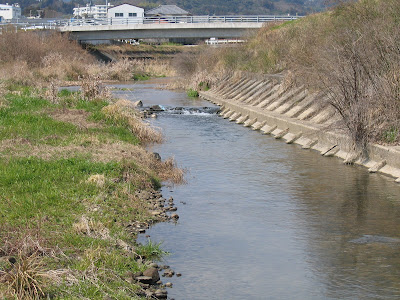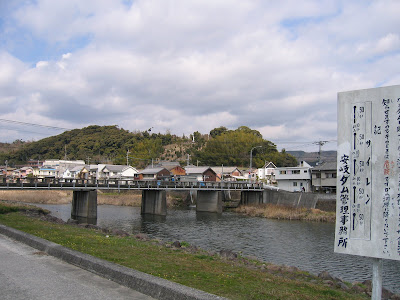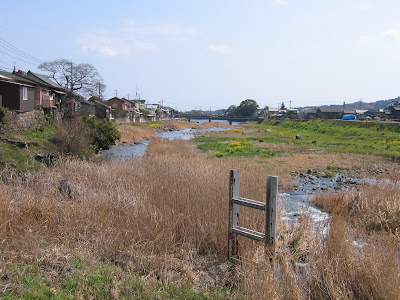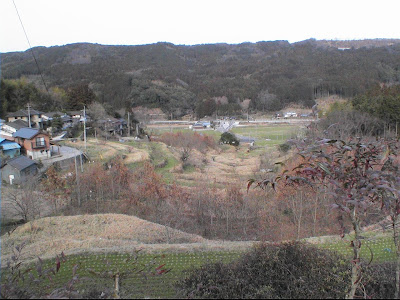March 2, 2009
Aki is the next town up the Kunisaki Peninsula after Kitsuki. It's most famous for being the location of the Oita Prefecture Airport.
Me and this airport go back a ways. It was the first part of Oita prefecture I ever saw when they flew us in on the JET program back in 2001. And I've flown in and out of it a few times in the years hence-- occasionally driving wildly up to the airport at the last minute hoping to catch my plane, like in this post here.
(Also when working my way through the Showa News Reels series last year, I learned that there was a deadly airplane crash at Oita Airport in 1964 [details on the Aviation Safety Network here].)
Aside from Oita airport, I didn't have a clue what else there was to see in Aki, but I had a whole day to wander around and find out.
First stop in Aki town was....well, it ended up being the airport again.
It was not originally my intention to revisit the airport, but all the major roads in Aki funnel right into the Oita Airport. Because I didn't know where I was going, before I knew it I was driving right into the airport.
Driving from Nakatsu, I had been in the car for close to 2 hours by this time, so I figured the airport was as good a place as any to stretch my legs, use the public toilets, and get a cup of coffee.

I was hoping to blend into the crowds, but once I walked into the airport I realized there weren't any crowds. Oita Airport isn't exactly the busiest airport in the world, and they must have been between flights, because at first I was the only customer walking around in the whole place. The eyes of every staff member seemed fixed on me, and I was worried someone was going to ask me what flight I was taking, and then I would have to answer that I was just wandering around the airport for pleasure's sake, and feel like a total loser.
Fortunately no one asked me, so I kept my dignity in tact.
Once I got up to the second floor, then I found several other people milling about. There was a small book store on the second floor that I browsed through briefly, despite the fact that they didn't have any English books.
The third floor of Oita Airport has an observation deck, where you can walk out and see the planes take off and land. I had been here before, but it's still pretty cool.
In fact, come to think of it, Oita Airport is the only airport I've ever been to that has an observation deck. I certainly can't remember ever going out on an observation deck back home in the US. I wonder if that's because of some sort of security reason, or for design reasons. Or have I just been missing them all these years.


After taking a few pictures off the observation deck, I went back down to the first floor and stopped at a cafe to get a cup of coffee. (The cafe was kind enough to give me the whole airport experience, and charge me $4 for a tiny cup of very weak tasting coffee.)
As the girl behind the counter handed the coffee off to me, she pointed to the condiment stand and added in Japanese, "the cream and sugar is right over there, enjoy your coffee."
"Thanks," I replied, also in Japanese.
One of the customers in line behind me began saying something to me. His pronunciation was so mangled it could me a few seconds to realize he was actually talking to me in English, and that he had decided to was necessary to translate for me what girl had just . "She said the cream and sugar is just right over there."
This was a bit odd, because I had been conversing with the cafe staff in Japanese, so I would have thought it was evident I was getting along fine on my own. But even if I hadn't understood Japanese, the concept of a condiment stand needed no translation. I knew what cream and sugar looked like, and what their function was, and the stand was directly in front of me, and the staff had clearly pointed right to it.
And finally, even by Japanese standards, his English pronunciation had been quite bad. If I did need help understanding the concept of cream and sugar, he was probably not the one to do it.
But everyone who's been in Japan has a hundred stories like this. (As a Japanese friend once said to me, Japanese people who are fluent in English don't feel the need to practice it all the time. It's precisely the people whose English isn't very good who feel the need to always try it out on foreigners).
Since he thought he was helping me, I thanked him, tried to smile politely, and hoped my annoyance wasn't showing on my face. I had the sense he wanted to continue the conversation, but I deliberately buried my face in my book to avoid having to talk to him.
In this last part I was perhaps a bit rude. In an ideal sense, us foreigners living in Japan should act as polite cultural ambassadors at all times, but alas, in real life we have our grumpy anti-social moments as much as anyone else.
After finishing my tiny cup of overpriced coffee, and reading a few pages in my book, I went back out to my car and decided to find out what else was in Aki town.
I managed to get away from the airport and find the downtown area of Aki. I parked my car in the supermarket parking lot, (and then went inside to buy a bottle of water, just so I could say I had an excuse for parking there).
Like a lot of these small countryside towns, there wasn't much to downtown Aki. I walked down the main street, passed a bank, a 7-11, another supermarket, a gas station, and that seemed to be about it.

There were two bridges crossing two different rivers on their way out to the ocean, and I walked along the bank of one river and got a picture of it feeding into the ocean.

Then, I continued walking down the main street until I got to the end of it, and then headed back down the same way.
Not knowing what else there was to see in Aki, on my way back I decided to follow the other river inland, going away from the ocean and towards the mountains.


It was a pleasant March day, when the weather was neither hot nor cold. And although it was still technically winter season, the first signs of Spring could already be seen on the ground. Yellow and purple wildflowers dotted the way all along the river bank.
Because it was such a pleasant day, and because the walk along the river was so beautiful, I kept on walking even though I didn't know where I was going. And I kept on walking. And walking. Until I had walked for a couple of hours along the river.


At one point the river intersected with another major road next to Aki Elementary school and Junior high school. I walked along the main road for a while here, and then came to the other river going through Aki. This was another one of Aki's population centers, and there were a lot of houses around this area, but there was still a nice path along the river. In one spot, someone had even planted several trees along the path creating a green awning to pass under.



I saw a statue up on a nearby hill, and started walking towards that just for the sake of having a destination.
Once I got to the hill, it seemed to be some sort of temple or shrine with a series of steps leading up.

Once I got to the statue on the top of the hill, I could get a good view of the town down below.


Instead of going down the stairs, on the way back down I followed a road going down the back of the hill through a green wooded area.

After this, I continued to walk down the river for a way (and past another elementary school, although this second one seemed to be deserted). Then I turned back and started to retrace my steps.

I found the Aki town hall near the schools, and stopped in to see if I could get any pamphlets or sight-seeing information about Aki.
There were a few pamphlets on Miura Baien.
I had no idea who Miura Baien is, but next to Oita airport he was obviously the most famous thing in Aki. I had been seeing his face all day on various signs, (although I hadn't known whose face it was until I saw the pamphlets in city hall.)
Apparently Miura Baien, whoever he was, was at one time a local boy who made it big, and has ever since remained the pride and joy of the city, much like Fukuzawa Yukichi (w) is to Nakatsu.
It was already after noon by the time I arrived at the town hall, and it would be at least another hour to walk back to my car. Would I have time to see the Miura Baien museum? I doubled my pace on the way back, and returned to my car as quickly as I could.
I got back in my car and drove out towards the Miura Baien museum.
(I realized, as you always do in these situations, the difference between traveling on foot and by car. The stretch along the river that it had taken me the whole afternoon to walk I drove by in 5 minutes).
I followed signs for the Miura Baien museum for 13 kilometers, only to find at the end of it that the museum is closed on Mondays.

Slightly down the road was Miura Baien's old house. The sign at the parking lot said it was open for business, but once I actually got out of the car and went around to the front I found that, guess what, this is also closed on Mondays.
I was able to walk around the outside of the house however, and take a picture.

For some reason, right around this time I got struck by a random sneezing attack. I'm not sure why. Maybe the sun was too bright, or maybe an early attack of spring hay fever. Whatever the reason, I started sneezing over and over again. And if you know me, I'm not a quiet sneezer.
The old ladies and the farmers in the neighboring gardens, who until this time had been more or less ignoring me as they continued to gossip with each other, now stopped and stared.
Trying to preserve what little dignity I had left, I walked around to the back of the house. There was a path up through the woods where you could see Miura Baien's grave.


I never did find out who Miura Baien was. And in fact, even after I returned to Nakatsu and asked my Japanese friends and students about him, very few people seemed to know. So his fame is apparently limited.
Nevertheless, a quick google search does bring up several sites on Miura Baien--for example this one here.
After this disappointing trip to Miura Baien's house, I got out the map again and began to think about where to go next. I decided to head in the direction of Aki Dam and Ikoino Park.
I'm beginning to feel like almost every city in Oita has a dam, and the dam in Aki was unspectacular.

There was a park at one end of it, which was completely covered in cherry blossom trees. And, as the cherry blossoms were not in bloom yet, the park looked very grey and dull.


I've never quite understood why the Japanese cover the whole country in cherry blossom trees which are only in bloom for 2 weeks out of the year. But then, the idea that life is fleeting is supposed to be the whole point.
There was some obstacle course equipment in the park (in various stages of disrepair) which I monkeyed around on for a while, and then drove on.
I got out my map again, and decided to go out Rurikoji, a temple which was marked out as a tourist destination.
Once again I found myself following signs down winding mountain roads until I arrived at the temple, which I found quite unremarkable. I'm sure if I had understood the history behind it I could have appreciated it more, but just looking at it I was slightly disappointed.

There were some other temples and tourist destinations located on my map, but at this point I decided I was tired of wasting gas driving all over. From Rurikoji temple I had a nice view of the valley down beneath, and the river winding through it.

So, I decided to just go for a walk along the river, stopping at various points to sit down and dangle my feet off the bank while I read my book, and then continuing on again.

When the 5 o'clock chimes sounded, I decided I had put in my time in Aki, and made my way back towards my car.
As I was driving out of Aki, however, I saw a couple more signs for another temple and a pagoda. Impusively, I turned my car down the road to take in one last sight before I left.
The temple was ordinary. Once again, I'm sure I would have appreciated it more if I had some knowledge of it's history. There were various signs for things marked Yasakasha, Itabi, and Goreisha, but to be honest I have no idea what any of this means.


The pagoda (Yamagasakunisakito, or Hoto) was particularly disappointing. When a sign says pagoda, I was expecting some sort of big building, and instead found just a small rock.

And with that, I bid Aki a fond farewell, and headed home.
Aki Links:
Another blog travelogue here. This post is both Aki and Kitsuki, but all the pictures up to Kitsuki castle are from Aki.
瑠璃光寺 Rurikou-ji Rurikoji Temple,
Link of the Day
· Noam Chomsky on 1968. New Statesman. May 8, 2008
Also A History of Anarchist Organizing in Grand Rapids






No comments:
Post a Comment